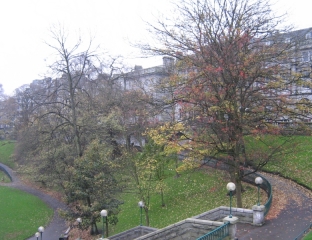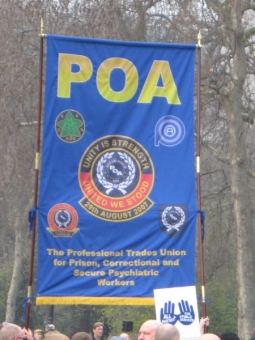Old Susannah takes a look at the events of the past week.
After another event-packed week in Aberdeen, Wednesday’s Press & Journal surprised on two counts. The cover tells me that the Scottish Government, previously strapped for cash, will give us £70 million to make our city garden project dreams come true.
All we have to do is show that we’re all behind Wood/Milne/Craw/Brough and all. Should be easy enough.
But, the surprising thing was that the story was illustrated with not one but two photographs taken inside the hallowed temple of design which is the Pier, and they clearly showed the exhibitions.
I was chased by security guards for taking a photo of the lovely stripy poster when I stood on Belmont Street, and several of the protestors were told in no uncertain terms that photographs of the great designs were absolutely forbidden.
I fully expect that Gerry Brough (or Sasha M maybe) will send the security guards straight over to P&J offices and demand that the photos be deleted. After all, a rule for one should be a rule for everyone. Otherwise people will get the wrong impression that rules are not uniformly enforced in our fair city.
The other item which surprised me pleasantly was an account of the recent Housing & Environment Committee meeting: Neil Cooney brought up some of the many reasons why the deer cull and tree planting on Tullos are not as popular with the public as they might be.
One other teeny omission that Ho Malone and other proponents of the bullets for trees scheme forgot to mention in their reports and consultations is the fact we’ll have to spray weedkiller on Tullos for 2-3 years. Result! This is jobs creation at its best, although you might not want junior riding his moped any time soon after the spraying has occurred.
One other minor detail – after all this fuss over the deer and press releases saying that everything is in readiness for the saplings – the city has not actually put in its formal bid for the tree scheme. This makes people like Pete and Ho look just a little foolish for saying that the scheme is cost-neutral.
I’m no accountant, but if you’ve not got any funding for a plan that failed before to the tune of £44,000, you might be just a little bit premature to announce that the great plan is ‘cost neutral.’ Neil also has this wild idea that the wildlife we already have on Tullos should be kept, and the hill be designated a meadowland / grassland – possibly deer park. Watch this space. (Thank you Neil from a great number of people).
The best events of the week save the Housing Committee meeting were the Pumpkin Procession and the Mooring’s Alternative Design Competition Award night.
At the Pumpkin Procession in UTG, a great selection of pumpkins were on display in the near darkness.
A particularly frightening carving of a witch disturbed the group greatly; this was of a famous witch named Margaret Thatcher.
Over two dozen bright, vibrant, dynamic, forward-looking, connectivity-rich, level-access, city-saving schemes for boring Union Terrace Gardens were on display at the Moorings on the night. These are still available for viewing on that Facebook thing the kids are using today.
See: Alternative-City-Gardens-Design-Contest
Believe it or not, I was allowed to take photos without security accusing me of any felony offence.
And I got to drink some nice beer called ‘Alhambra’ – named after a rather boring bit of architecture in Spain which has far too much garden space incorporated, and actually no parking or shops. Shocking. No one will ever go to the Alhambra just for a visit (unlike our forthcoming glass worm). The Moorings winner didn’t get £135,000 (which is what I believe you get if you were shortlisted for your monolith or Teletubby habitat), but got a bottle of drink instead.
All things considered, I think the finalists at the Moorings should have been given great wads of money and the official designers should have been told to stay off the drink when working.
The winner’s design had suggested putting AFC’s stadium in UTG, but this leaves the problem of what then to build in Loirston, which has for far too long just been a meadow.
But at this rate there won’t be any definitions, so here goes.
Outburst
(noun) an uncontrolled, sudden verbal attack, usually unsuspected.
Dear oh dear. The credit crunch is having a devastating effect on so many of us. I can’t even get to BrewDog as often as I’d like for openers. But spare a thought for those less fortunate than us who are really feeling the strain at this difficult time.
Do you know someone who’s having to sub an unprofitable football team? Someone who’s year-end profit wasn’t all that big (although whether or not that’s true outside of the UK is anyone’s guess)? Someone perhaps who is facing a big legal action over a land purchase deal? And you thought you had problems!
Some of us are down to our last 60 mill or so. Such strains could easily make you tear your hair out. Or be grumpy. Or even have a wee outburst. Before you make fun of such a person because they seem like a child who’s thrown his toys out of the playpen, just think : it could be you who’s lost your temper/grip. The last thing we should do is call attention to such a temporary lapse of reason/class/reserve.
Therefore, if someone sends you a link to a video where such an outburst is captured, best thing you can do is stay clear. For purposes of illustration, I have just such a link here, wherein a normally lovely bloke has an uncharacteristic outburst and makes something of an exhibition of himself. So pity such a creature. They may have come from a broken home.
See: Stewart_Milne_Outburst_Video_Article
Nanny State
(modern English phrase) a derogatory term to describe an overly interfering government, particularly from the UK’s past.
I am eternally grateful to those wiser heads than ours in government who want to protect everyone from the ills and evils of drink. There are people who have problems with drink; and drink driving is a threat to everyone – I say without any sense of sarcasm; I’ve lost too many loved ones to drink drivers. Rather than helping people with drink problems, the best thing to do is make drink more expensive for everyone.
The SNP previously tried to save us all from the great evils of Marks & Spencer’s ‘eat in for a tenner’ scheme (as I previously detailed). This was a plot by the sinister M&S to give us affordable four-dish meals to eat at home with another person.
It’s clear to see where this kind of thing could lead – one thing leads to another as you progress from a ‘herb’ salad to a rump steak with onion ‘rings’ on the side while sharing a bottle of red wine before moving on to dessert (I had profiteroles with my meal last week – it was delicious. OOPS!)
Having been as successful at banning these society-destroying balanced meals as they were at making Scotland independent, the SNP have decided to raise the price of alcohol.
This will immediately result in alcoholics quitting booze cold turkey. Kids will no longer wish to experiment with alcohol, and the world will be a better place. Since Scotland doesn’t have much of a vibrant or dynamic alcohol presence in the world’s drinks market, there will be no economic repercussions at all.
Nanny Goats
(noun type of goat; female)
I don’t know where we would be without the ‘new-look’ Scottish Natural Heritage agency to make sure we have a perfect natural world with as few deer, foxes and goats as possible. For the movers and shakers (or ‘empire builders’ and climbers if you will) of SNH want to destroy the Tullos Hill deer (and other deer), and they are making sure we don’t have too many goats on the remote Isle of Rum.
To ensure that we have a perfect balance of nature, it seems SNH had a nice quantity of the goats shot, as reported in the Sunday papers.
What intelligent method was used to get rid of the corpses? Were they fed to birds of prey? No, they were allegedly thrown off cliffs into the sea. The SNH denies this, but it is their word against the word of observers. Seeing as how the SNH wrote to Aberdeen City Council encouraging a sneaky approach to the Tullos Hill deer cull, I might not be inclined to believe them all the time.
It is almost as if someone at SNH wanted to make a name for themselves and was running around getting as much media coverage as possible, and was using draconian, cruel animal slaughter to get press attention. But remember, the world was a far less balanced, manicured, less managed place in the days before SNH got into the killing, sorry, culling or ‘managing’ game.
We now have targets as to how many animals a patch of land can hold. This is of course not control-freakery. If the animals don’t stick to the figures, well then, they become the targets for hunters.
Of course if such a person existed, they would have quite a job of silencing other experts who clung to old-fashioned ideas about not shooting animals to maintain the new population figures. This would never happen of course.
However, if you want to ask any questions to reassure yourselves that all is right and proper in the world of animal ‘management’ at the SNH, feel free to write to Jamie Hammond. He really does have all the answers, and is in no way faddist or revisionist in his proposals for animal management. Tally Ho!
Next week: more definitions and an update on our poor stressed out friend.










